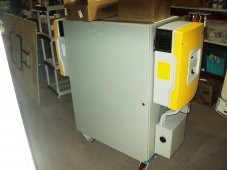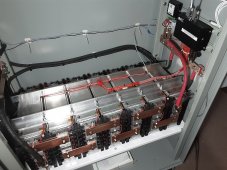I’m not new to solar systems, having built my own off-grid system with DIY EVE 280Ah LiFePO4 cells, a Growatt 3000W all-in-one inverter, and 2000W of solar panels. I understand grid-tie systems, but have not worked on them. I’ve learned a lot from this forum and Will’s videos.
So I thought it wise to reach out to this community when a family member in California who has a Sunrun-installed residential grid-tie system asked me to help him design and install a battery backup to his system, given the increasing threat of power outages in that state.
The specs on his system are:
- 30 panels, 350W each for a total capacity of 10.5 KW
- Solar feed is a single feed into a Solaredge HD Wave inverter (I believe it’s the SE 7600 model). Input labels on inverter state max input of 450V and 32A. Output of inverter is 240V AC.
- The AC output of the inverter is passed through an AC shutoff box, before being routed to the main circuit breaker box, where it is coupled to the panel through a pair of 40A breakers.
- We have confirmed that shutting off the grid input shuts down the inverter AC output, as it should.
I’ve read enough to know that the battery backup system (inverter and batteries) can be set up via AC-coupling or DC-coupling. Based on my experience, I think DC-coupling would be easier in his system, but requires a largish inverter that can handle the 450V input, of which there are several. Ideally, during a blackout with the grid down, I’d like to use the solar panel DC power run through an off-grid inverter to run essential loads and charge the batteries during the day, then rely on batteries for the essential loads at night. Essential loads can be 120V only, but 120/240V are preferable.
What do you folks think? Is DC-coupled practical here, and how would I wire it in? Should I attempt a schematic for review?
Thanks!
So I thought it wise to reach out to this community when a family member in California who has a Sunrun-installed residential grid-tie system asked me to help him design and install a battery backup to his system, given the increasing threat of power outages in that state.
The specs on his system are:
- 30 panels, 350W each for a total capacity of 10.5 KW
- Solar feed is a single feed into a Solaredge HD Wave inverter (I believe it’s the SE 7600 model). Input labels on inverter state max input of 450V and 32A. Output of inverter is 240V AC.
- The AC output of the inverter is passed through an AC shutoff box, before being routed to the main circuit breaker box, where it is coupled to the panel through a pair of 40A breakers.
- We have confirmed that shutting off the grid input shuts down the inverter AC output, as it should.
I’ve read enough to know that the battery backup system (inverter and batteries) can be set up via AC-coupling or DC-coupling. Based on my experience, I think DC-coupling would be easier in his system, but requires a largish inverter that can handle the 450V input, of which there are several. Ideally, during a blackout with the grid down, I’d like to use the solar panel DC power run through an off-grid inverter to run essential loads and charge the batteries during the day, then rely on batteries for the essential loads at night. Essential loads can be 120V only, but 120/240V are preferable.
What do you folks think? Is DC-coupled practical here, and how would I wire it in? Should I attempt a schematic for review?
Thanks!





